The world still proceeds with caution since the COVID-19 virus was identified earlier this year. But as we learn more about the virus and watch our communities, we can begin to make plans to travel again. International travel between Mexico and the United States is open. But interestingly, only by air travel. Travel by automobiles across the border is closed.
When I arrived at the Cancun International Airport, I found Mexican businesses cautious and responsible. Masks were required (for the most part) while indoors. My husband and I took precautions and decided we were ready to venture out, and our destination was the Mayan Riviera.
The Mayan Riviera is a grand development of resorts along the east coast of Mexico. It spans from Cancun to Playa del Carmen. Thirty years ago, the terrain between these two cities was a lot different when my husband and I spent our honeymoon exploring this area.
Back then, we drove through the jungle in a rented Volkswagen, leaving Cancun behind with its high-rise hotels and expansive pools and headed to Playa del Carmen. Few cars were on the narrow, paved road, but we saw men with machetes, cutting back the encroaching brush, children running up to our car and hanging onto the rolled down window sill, laughing and trying to sell us stuff as we slowed down in villages, and the occasional coatimundi running along the roadside.
Today, a well maintained four-lane highway connects the two resort cities. Buildings and impressive gated entrances for vacation properties break up the dense vegetation. I hardly recognized this urban sprawl against the sleepy jungle I once knew.
When my husband said that he planned a trip to the Yucatan Peninsula for our anniversary, red flags flew up. Countries around the world were still hesitating in opening up fully to tourists. Most European nations didn’t want us (Americans). Canada extended their ban on non-essential travel until September as of this writing, and the Mexican government had closed down its public beaches for the second time. Even my own hometown of Las Vegas was still in the infant stages of opening up with some casinos still closed and restaurants keeping occupancy down for social distancing.
Information was sketchy, coming out of Mexico. What could a tourist do? What was open? Were we going to experience imposed quarantine like so many beach locations in the U.S.? After questions were tossed back and forth with our connection in Mexico, we decided to forge ahead with friends who also wanted to “get-away”. Celebrating our anniversary was a good reason to check out the travel environment.
Our flight arrived at ten in the evening on August 9th. Agents took our temperature with thermal scanners and waved us through. We had passed with a 36 degree Celsius reading.
The scene at the airport looked like a typically busy summer. Our plane was full (except for the middle seats that Southwest imposed for social distancing) and the lobby quickly filled up with disembarking passengers. There were plenty of taxis waiting outside to take folks to their destinations.
Checking into our resort on the Mayan Riviera was fast and efficient. We found out that the property was only 30 percent full. That made for easy access to dining at restaurants and quick service . It also meant that some amenities on the property were unavailable. Entertainment that normally took place at different venues was limited. Some restaurants were closed. The tour desk had scaled-down hours. Making the best out of the situation, we enjoyed the large pools with their swim up bars and the fully open beach with its many vacant lounge chairs and Palapas.
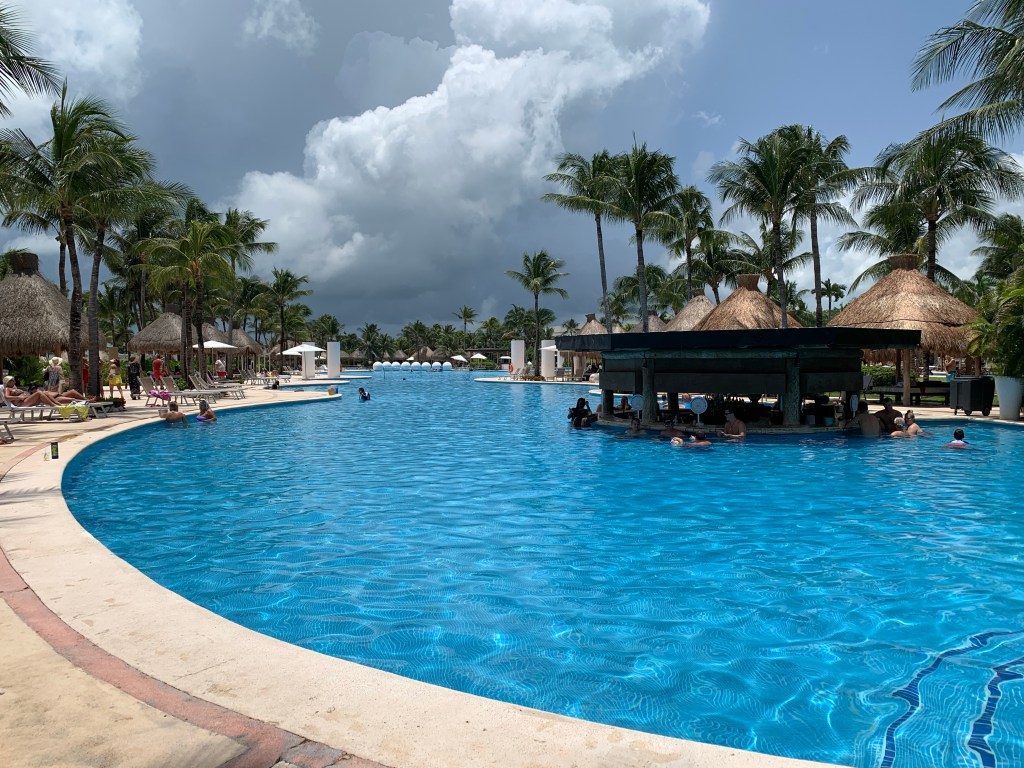

The staff observed COVID policies and wore masks the entire time. Guests were asked to wear their masks while indoors. Hand sanitizing stations were everywhere. We felt very comfortable with how the resort handled Pandemic times.
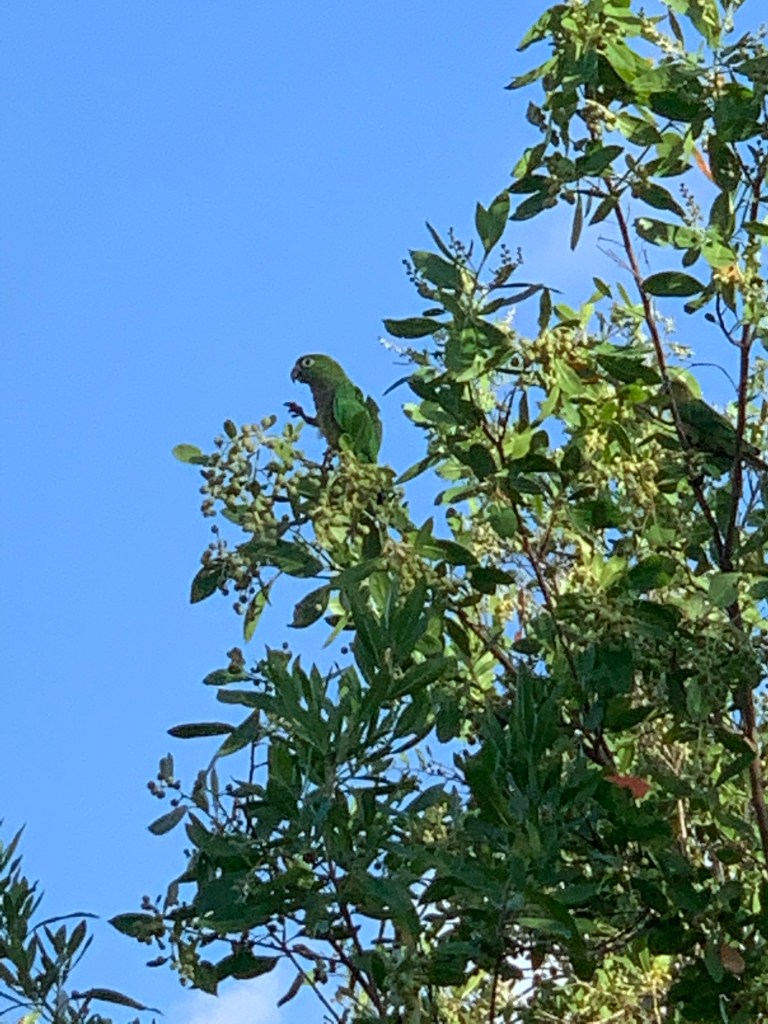
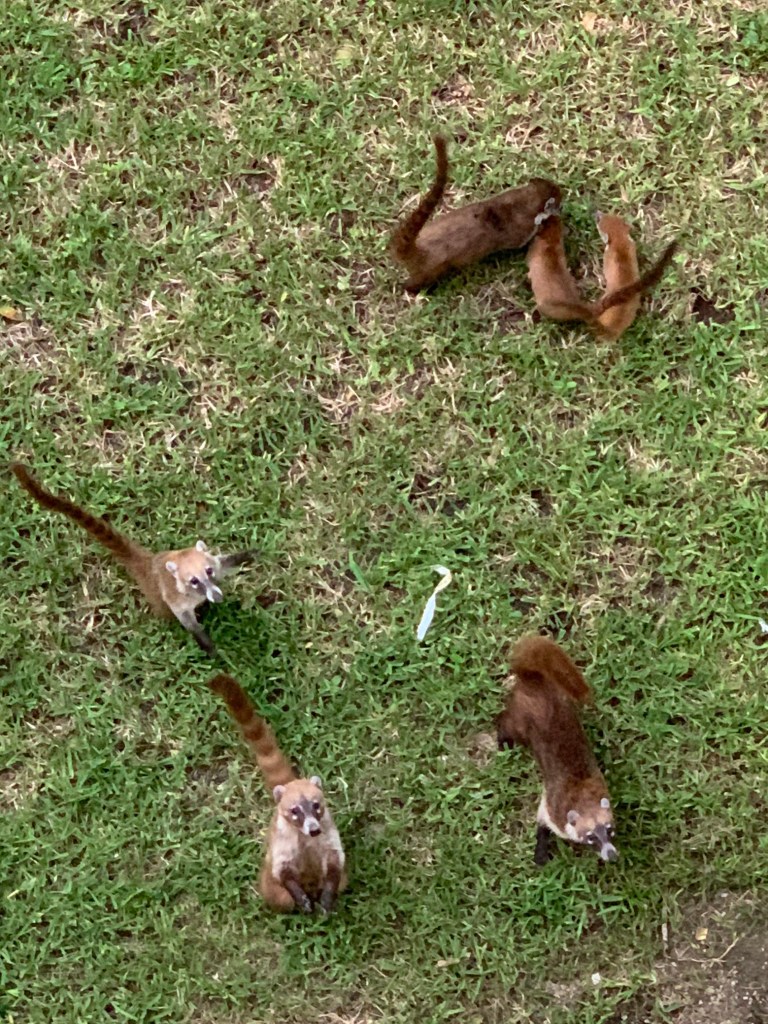

I was delighted to see that the resort worked in harmony with the natural inhabitants that were living on the 1000 acre property. We marveled at the parrots that flew in during the mornings, picking away at berries in the trees and squawking about it. Iguanas sunned themselves on the walkways throughout the grounds, and coatimundis came out at dusk to forage for food and play in the surrounding landscape.
We were curious about other areas near our resort and took a taxi into Playa del Carmen. We went to the famous 5th Avenue and saw many businesses shut down or boarded up, however, those businesses that were open were very busy.
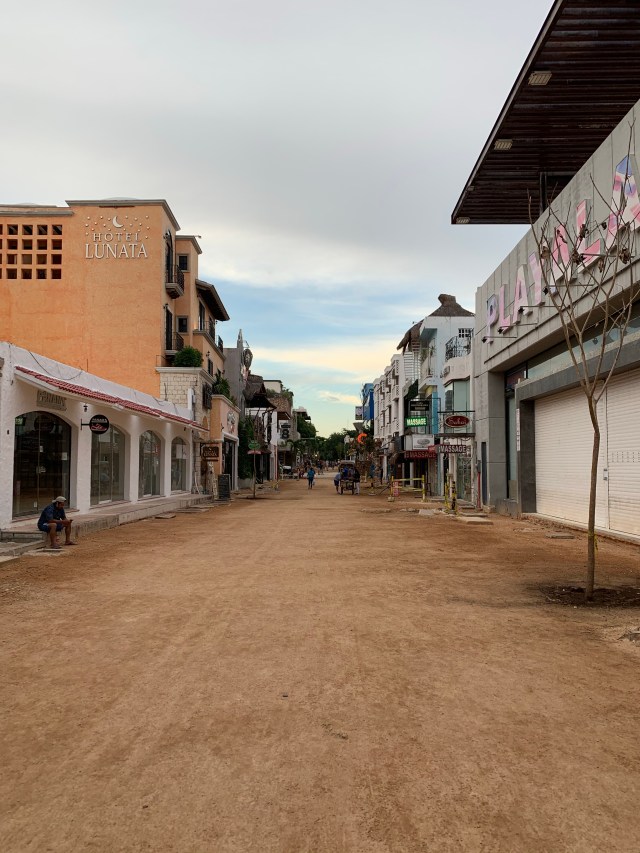
5th Avenue, Playa del Carmen
We found a beach bar open and had cocktails. The beach wasn’t crowded. A few folks walked along the shore and some paddle boarders and swimmers were in the water. By all indications, this public beach didn’t look closed down.

Later we enjoyed dinner at the Sonora Grill Prime on 5th Avenue. We simply stumbled onto it, having made no reservations. Business was slow, and we had no problem getting a table. Our temperature was taken before entering the dining area, and both staff and guests walking through the dining area wore masks. We felt entirely safe. Our dinner was delicious. It is a place that we will come back to.
The following day we booked a day trip to Rio Secreto. It was one of the few tours available in the area. Popular tours to the Mayan ruins were closed during our stay. Rio Secreto is an underground river and cave system. Limestone caves and cenotes (large holes in the ground filled with water) populate the Yucatan Peninsula. I was thrilled to have the opportunity to explore one.
We were picked up at our hotel by the tour company and drove south of Playa del Carmen eventually turning off into the jungle. For another 20 minutes we traveled on dirt roads through dense jungle until we arrived at a small complex set up with lockers and showers. Our guide greeted us and then instructed us to gear up in wet suits, life jackets and helmets.
Our small group of ten proceeded along a narrow dirt path through the jungle. Anna, our guide, pointed out the hazards of the jungle, warning us not to touch the bark of a tree we passed. It left a terrible burning sensation on your skin. An antidote had to be applied to neutralize the pain. Yikes!
A shaman waited for us near the entrance of the cave and performed a religious ceremony, swinging a bowl of incense in front of each person. It was to appease the gods and ask permission to enter the cave. We repeated words of thanks in the native Mayan language, and then proceeded down wooden steps into the mouth of the cave.
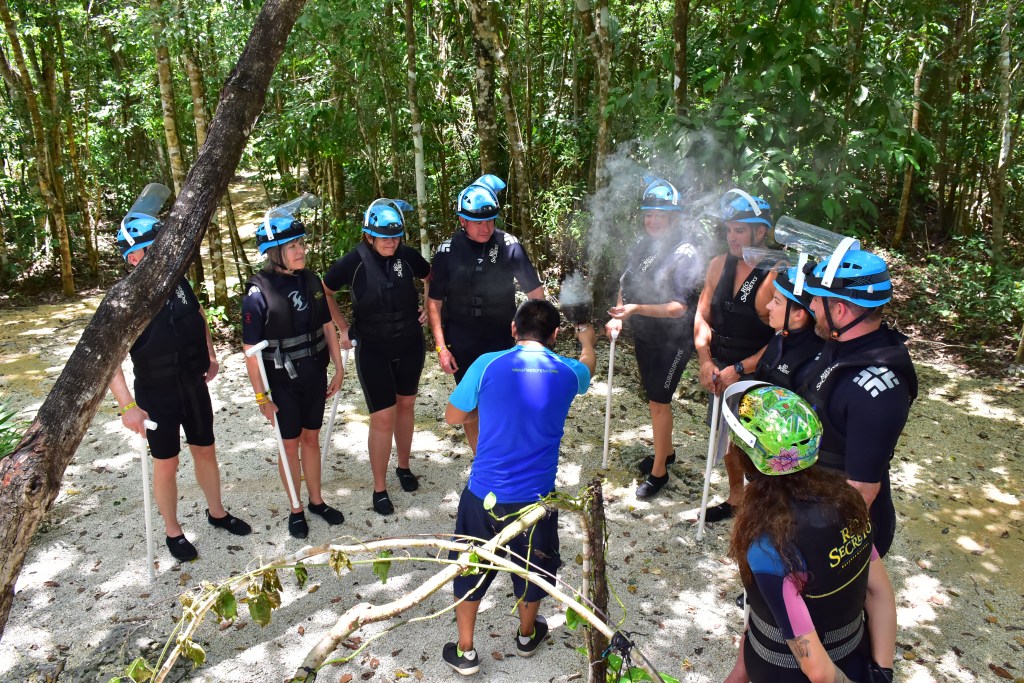
An unexpected boom exploded overhead. I glanced up to see billows of dark clouds standing ominously near. It was thunder. Minutes ago the sky had been clear. Was this an omen? We continued our descent. Reaching a flat stone floor inside, we stopped momentarily, and Anna asked if we had any questions. Someone asked a question that was now on all of our minds, Should we be worried about the water level rising during our tour?
We were fine, Anna assured us. The water levels rose no more than 3 meters during a continuous, hard rain.
The water and cave were a comfortable 75 degrees. This was a welcomed break since the weather was in the high 80’s with a humidity factor of 90 percent.
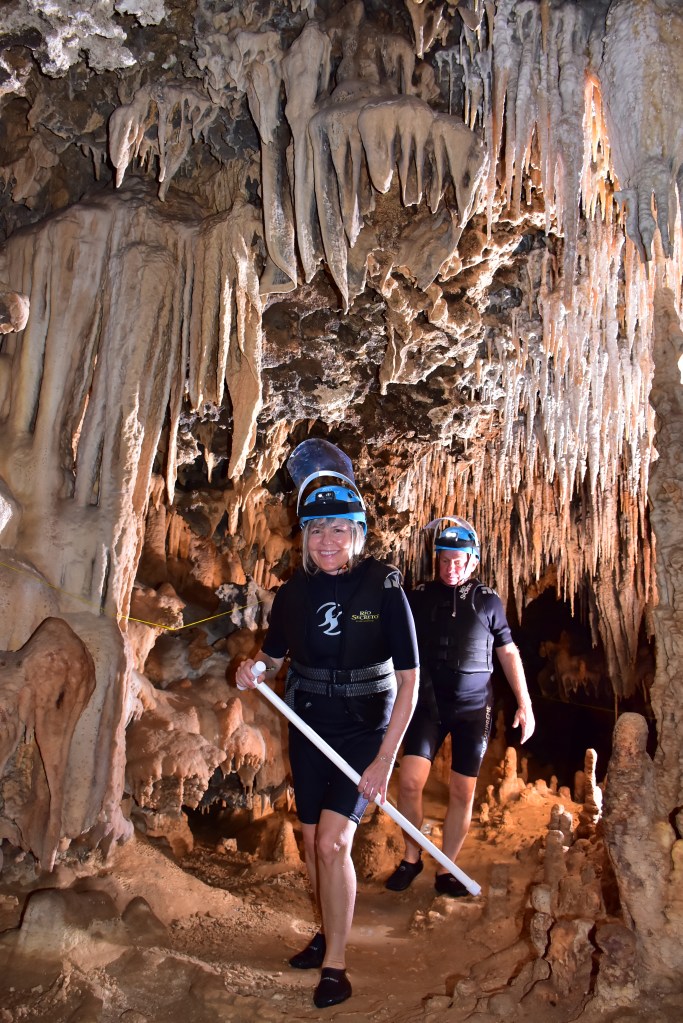

From the dry cave floor, we walked into the low, flowing river. It was exceptionally clear. Through narrow passages and expansive chambers, we carefully stepped around outcrops of rock and crevices. Using PVC walking sticks to assess the ground ahead of us, we became aware of holes and different depths of the water. Many times, the guide and her assistant helped us with our footing.
Stalactites and stalagmites in shades of cream and amber adorned the walls of the cave. Anna pointed out sponge-like formations on the ceiling, telling us that we were looking at ancient coral. The cave was once under the ocean. A few creatures also occupied the cave; bats, catfish, tiny shrimp and blind insects with antennae 4 inches long. Someone asked if there were snakes. Fortunately, we didn’t have to worry about these slithering reptiles. They didn’t live in the cave.
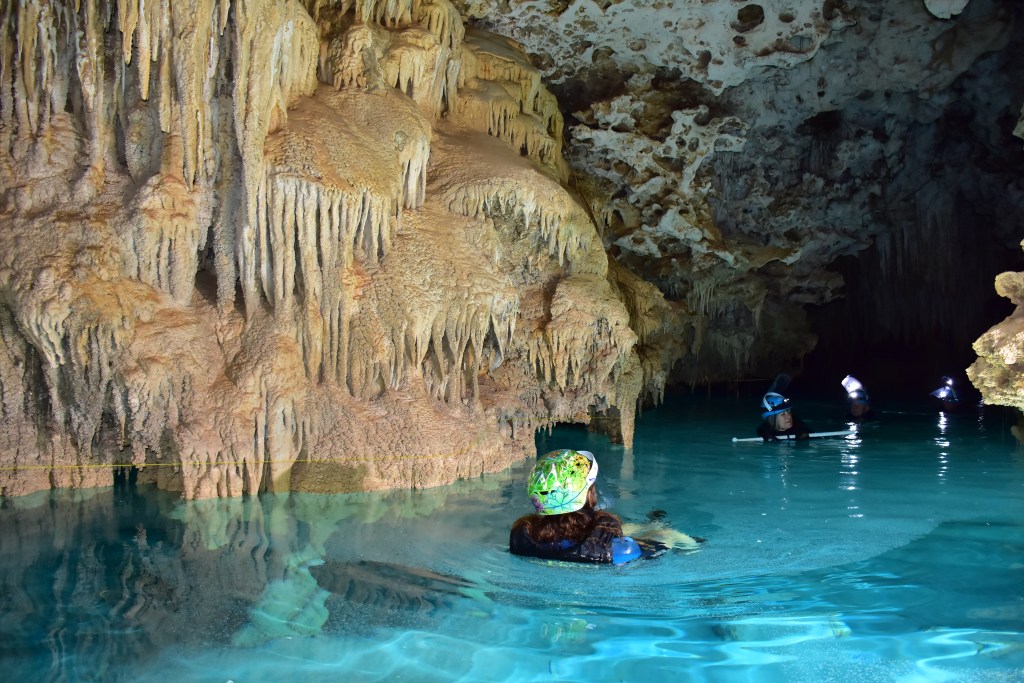
Our journey ended in a chamber called “the pools.” Here we took a moment to float on our backs and relax. Peace filled the room as our voices quieted down. Anna then announced that the lights, strategically placed throughout the cavern, would be turned off. In complete darkness, I felt as if I was floating in space. Silence surrounded our group until I and another tourist heard a rhythmic whoosh pass by. It was a bat. Vampire bats were one of the species that lived in the cave. My exceptional, meditative experience came to an end knowing this, and fortunately, Anna turned the lights back on.

There is no doubt that the COVID-19 has changed tourism. Folks are still concerned about travelling. Tourist numbers are down which affects services. We found that the more flexible we were, the more we enjoyed our stay. People in the tour industry were willing to spend more time with you whether it was to frequently check on your needs beside the pool or slow down a tour through a cave. Anna told us that normally 300-400 people went through the cave in a day. On our day, the tour had only 70 booked.
Eventually, tourist destinations will start operating at full capacity. We took our precautions, using masks, washing our hands, and not touching our faces. It has been two weeks since our adventure and we are fine. In these times, flexibility and patience are going to be your best tool navigating through the world of travel.

That was awesome Rox, I ventured into Rio Secreto two years ago when on a girls trip cruise, it still looks fabulous. Glad you were able to share this with your travel followers
LikeLike
Thank you so much.
LikeLike
I love your detailed descriptions, it feels like I’m there! 🙂 This was enlightening to hear during the covid!
LikeLike